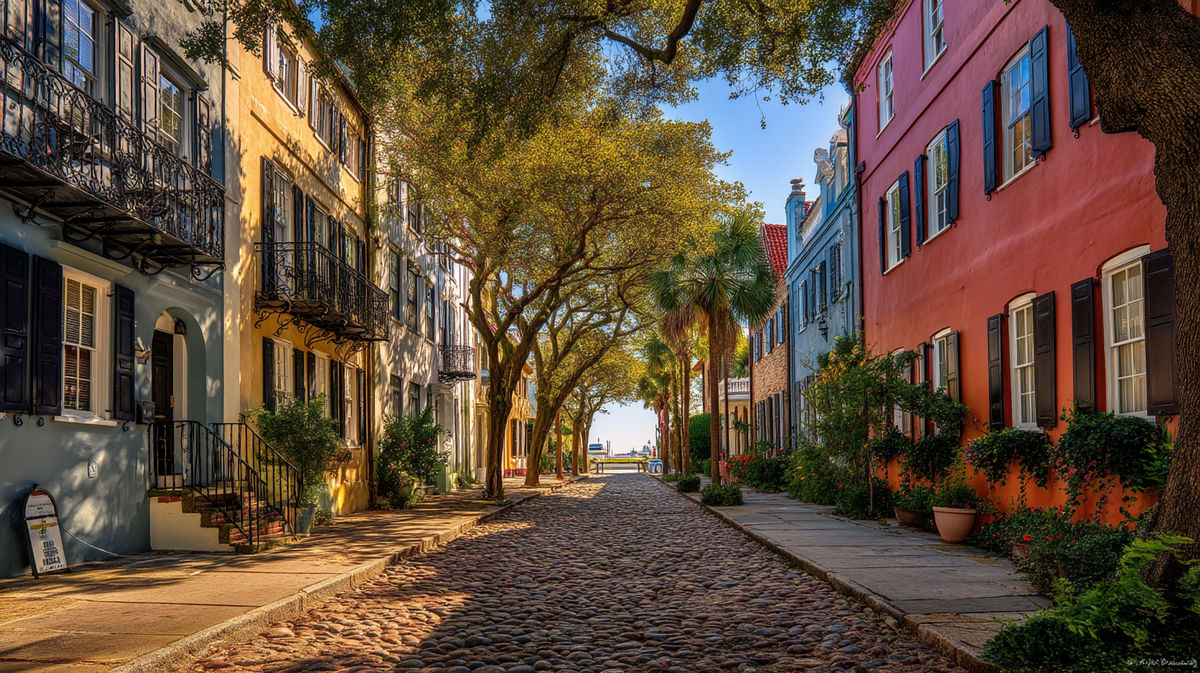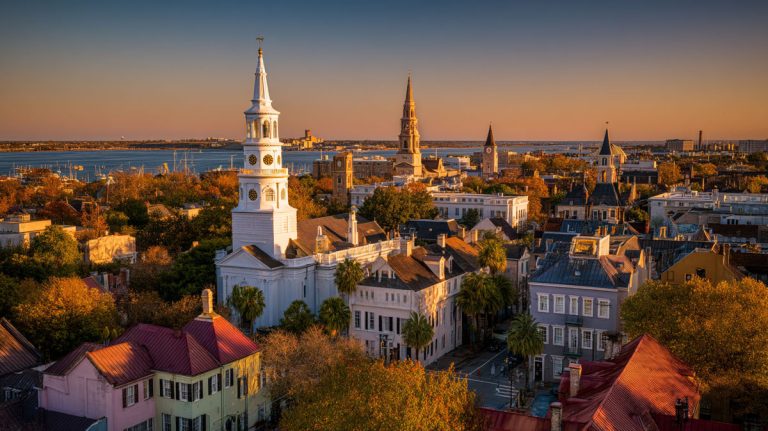Why Charleston’s Historic Homes Are National Treasures
A Brief History of Charleston’s Architecture
Stand on any block in Charleston and you’ll feel the city’s rich architectural history unfolding in layers, from colonial Charleston cottages and Georgian town houses to the high‐style Federal mansions of the early republic, the Greek Revival grandeur that followed, and the fanciful Victorian porches that closed the 19th century.
Because Charleston never lost its port-city hustle, each era left recognizable footprints instead of bulldozed blanks, allowing today’s visitors to trace three centuries of design in a single stroll.
Preservationists often point to the Charleston single-style home, a slender, one-room-wide “single house” turned sideways to the street, as the thread stitching those eras together.
Its trademark side piazza and center staircase survive in wood, stucco, and brick versions all over downtown Charleston, proving that modest footprints can still nurture elegance.
What Makes a Home “Historic” in Charleston
So, when does a historic house become an officially protected artifact? Locally, age is only the first hurdle.
A property usually needs to be at least 50 years old, retain most of its original historic materials, and sit within a recognized district or earn individual landmark status (many hold the coveted National Historic Landmark designation).
The city’s Board of Architectural Review, along with nonprofits such as the Historic Charleston Foundation, enforces guidelines that dictate everything from window mullion profiles to the paint you can brush on a kitchen house wall.
Owners who play by the rules can apply for state and federal tax credits that soften restoration costs, credits worth up to 25 percent of qualified rehab expenses in South Carolina alone.
Popular Historic Neighborhoods in Charleston, SC
The French Quarter
Cobblestone underfoot, church steeples overhead, the French Quarter proves that Charleston offers more than postcard views.
Galleries spill out of 18th-century storefronts where Huguenot bankers once balanced ledgers; at night, candlelit courtyards echo with jazz. Slip down Chalmers Street, one of the last true cobblestone lanes, and you’ll pass the Old Slave Mart Museum before emerging beside Charleston Museum partner sites.
Every block balances commerce and residence, letting you imagine life inside a historic residence while grabbing an espresso on the corner.
South of Broad
Cross Broad Street, yes, Meeting Street will get you there, and you’re suddenly in a living museum of antebellum wealth. South of Broad showcases Rainbow Row, that pastel string of 1740s merchant houses reborn in the 1930s restoration wave that sparked modern preservation nationwide.
Today, the area’s High Battery seawall offers views of Charleston Harbor, while interiors hide ornate plaster ceilings, imported marble, and the rare historic textiles gallery tucked behind a wrought-iron gate.
Owning here means embracing quirks “due to the historic nature” of brick nogging, hand-blown glass, and centuries-old foundations.
Harleston Village and Beyond
West of King Street, Harleston Village feels downright neighborly, students from the College of Charleston share sidewalks with families renovating 1870s duplexes.
You’ll still find grand homes facing Cannon Park, but the vibe leans walkable and social. Similar pockets, Ansonborough’s Greek Revival gems, Radcliffeborough’s early Victorian rowhouses, fill gaps between commercial corridors, proving that “best Charleston” depends on your definition of charm.
Living in a Historic Home: What to Expect
The Charm and the Challenges
Sliding into a historic Charleston home feels like time-travel with modern Wi-Fi.
Exposed beams share space with smart thermostats, and that hand-hewn lintel over the fireplace probably predates the first steam engine.
But be ready: uneven heart-pine floors, idiosyncratic room sizes, and occasional sea-breeze moisture mean constant attentiveness. Many newcomers learn fast that a dehumidifier is as crucial as sweet tea.
Preservation and Pride
Ask any owner and they’ll tell you that stewardship beats inconvenience.
Safeguarding a piece of Charleston history, maybe even the “home was the town home” of a signer or sea captain, earns you community bragging rights and, sometimes, a tax break.
Groups like the Historic Charleston Foundation or neighborhood guilds host workshops on repointing lime mortar and offer grants for authentic shutters.
Saving a cracked marble step isn’t just a repair; it’s owning a piece of Charleston for the next generation.
Buying a Historic Charleston Home: What You Need to Know
The Buying Process
Inventory is slim but alluring – search engines brim with “historic Charleston homes for sale” and “homes for sale in Charleston,” yet each listing tells a long story.
Partner with an agent who lives and breathes historic real estate; they’ll translate BAR rulings, secure specialized inspectors, and track down centuries-old deeds.
Because these properties sit in conservation zones, closing timelines hinge on extra sign-offs, but patience pays dividends in character.
Financing and Restoration Considerations
Lenders view a plantation house differently than a vinyl-clad ranch.
Expect appraisals to factor in craftsmanship, not just square footage, and budget for Phase I archeology if you plan substantial alterations.
Federal 20 percent rehabilitation credits pair nicely with South Carolina’s incentives, helpful when reproducing a cypress cornice or stabilizing a foundation built before the Declaration of Independence was inked.
Remember: any tweak must respect the historic nature of the house; stainless-steel cable railings rarely fly on a Charleston single-style home porch.
Is a Historic Home in Charleston Right for You?
Picture sipping coffee beside a 12-foot window while church bells mingle with gull cries, if that resonates, a historic home might fit.
But if you’d rather install floor-to-ceiling sliders tomorrow, modern construction may save heartache.
The key question: Do you feel called to keep Charleston’s historic heartbeat alive, or simply to live near the beach?
Either answer is valid; Charleston’s suburbs hold plenty of new builds, while the Charleston Peninsula preserves brick-and-piazza romance.
Plan Your Visit, Explore Charleston’s Past And Make It Your Future
Ready to move from daydream to deed?
Guided tours such as Charleston Strolls wind you past the Nathaniel Russell House Museum, with its famous free-floating staircase, the Joseph Manigault House, and the Aiken-Rhett House Museum with unrestored slave quarters that whisper truth.
Pay for tickets to tour these landmarks, note what “home of Thomas Heyward” craftsmanship feels like, then hop online to scan “historic homes for sale” filtered by South of Broad or the French Quarter.
Whether you crave views of Charleston Harbor or the shade of High Battery oaks, the city’s historic places invite you to write the next chapter.
FAQ’s About Historic Homes in Charleston
How old must a property be to count as “historic”?
In Charleston, the threshold is generally 50 years, but architectural integrity and neighborhood context weigh heavily. Homes inside protected districts face BAR oversight, even for paint colors.
Are there tax perks for restoring a historic house?
Yes. South Carolina’s state credit can refund up to 25 percent of qualified rehabilitation costs, and federal programs add another 20 percent for income-producing properties.
Can I install modern amenities like elevators or solar panels?
Often, but approvals hinge on visibility from the street and compatibility with existing materials. Discreet placement and reversible installation help win BAR consent.
Which house museums should I tour before buying?
Don’t miss the Nathaniel Russell, Joseph Manigault House, the Heyward-Washington House (aka Charleston’s Revolutionary War house) and the Aiken-Rhett House Museum. Each illustrates different eras and restoration philosophies.
What does “Charleston single house” mean?
It’s the iconic one-room-wide form turned perpendicular to the street, with a long side piazza catching coastal breezes—practical Lowcountry engineering wrapped in beauty.





